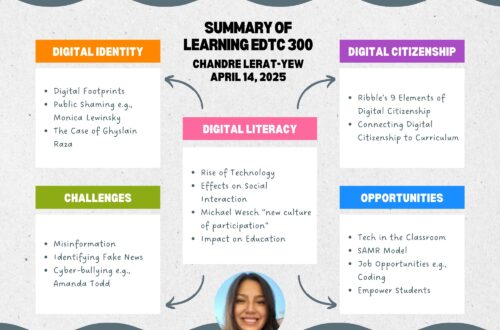How Technology Shapes Us

After our lecture and watching the video by Wesch, I’m beginning to understand how technology influences the way we interact with each other. Technology has changed so much in our world! We have access to endless information with one device. More so, students aren’t just consuming information anymore; they’re actively connecting, creating, and sharing their thoughts in a digital space. Whether it’s through social media, memes, or video games, the way we socialize with each other has changed. This is referred to as the new culture of participation by Welsch. Similarly to what we discussed in our lecture, people are no longer consuming media via radio and TV. Rather, we are constantly creating digital footprints; for better or for worse! This shift in technology changes how we should think about education.

Implications for Our Classrooms and Schools
Since technology has changed how we learn, it’s clear that we need to rethink how we educate our students. Educators need to recognize the significance of our digital world. For example, this article states, “46% of teens say they use the internet almost constantly”. With the magnitude of technology in our daily lives, educators need to teach our students about digital literacy. On one hand, concepts such as digital footprints, critical thinking skills, and digital citizenship should be taught to our students. On the other hand, we should also teach our students how to use technology as a tool for creating connection, learning, and community! Our digital world isn’t going away any time soon, so we need to teach our students the skills to create a safe environment online. If you’re interested in reading about specifics, I found a policy planning guide for schools in Saskatchewan to implement digital citizenship education from K-12.
Balancing Challenges and Opportunities
While the digital world offers incredible possibilities for learning and community-building, it also presents challenges such as unequal access to technology, cyberbullying, and screen addiction. Ways to balance these challenges might include:
- teaching skills to reduce screen time
- schools ensuring all students have equitable access to technology
- creating spaces for in-person connection
Ultimately, our education systems must evolve to prepare students for a world where digital participation is key. This means providing students with the knowledge and skills to make informed decisions. In this way, we can support their ability to adjust to our continuously changing digital world.



3 Comments
Camryn Erickson
I agree that it is also very important to teach skills on how to reduce screen time, it is not something I even considered. At the end of the day, we do not know how much time our student’s are spending on technology when they leave the school, trying to use it in an effective way, while also not overdoing it, is extremely important for balance.
Carys Moffatt
Reducing screen time skills is so important. People can get stuck in a constant loop of scrolling and think they’ve only been on an app for 20 minutes but it ends up being 3 hours! Even I can see my screen time climbing without even meaning for it to. Teaching students healthy habits on balancing screen time and reality is very important.
Jasmine Kaur
Hi Dre, You shared a great reflection on how technology is reshaping education and social interaction! I agree that educators must balance digital literacy with fostering meaningful in-person connections and ensure students have equitable access to technology. It’s an exciting challenge for the future of education!